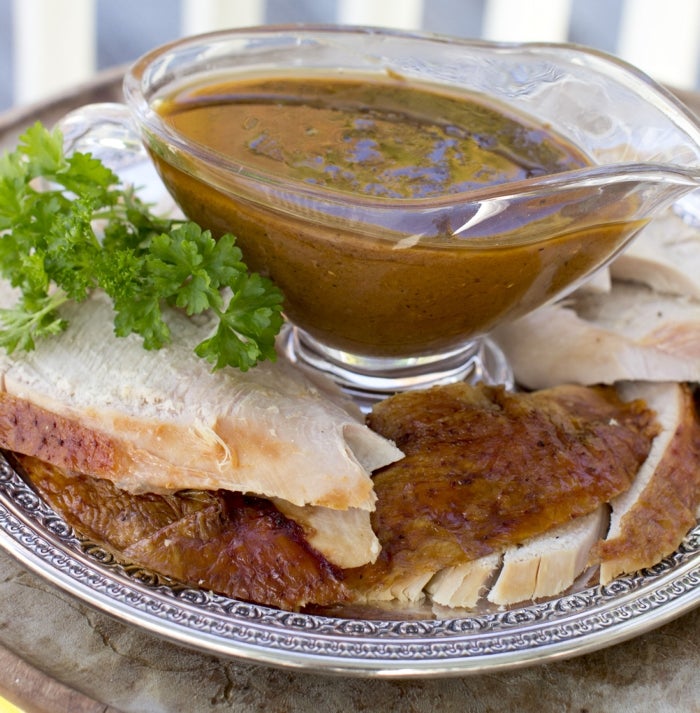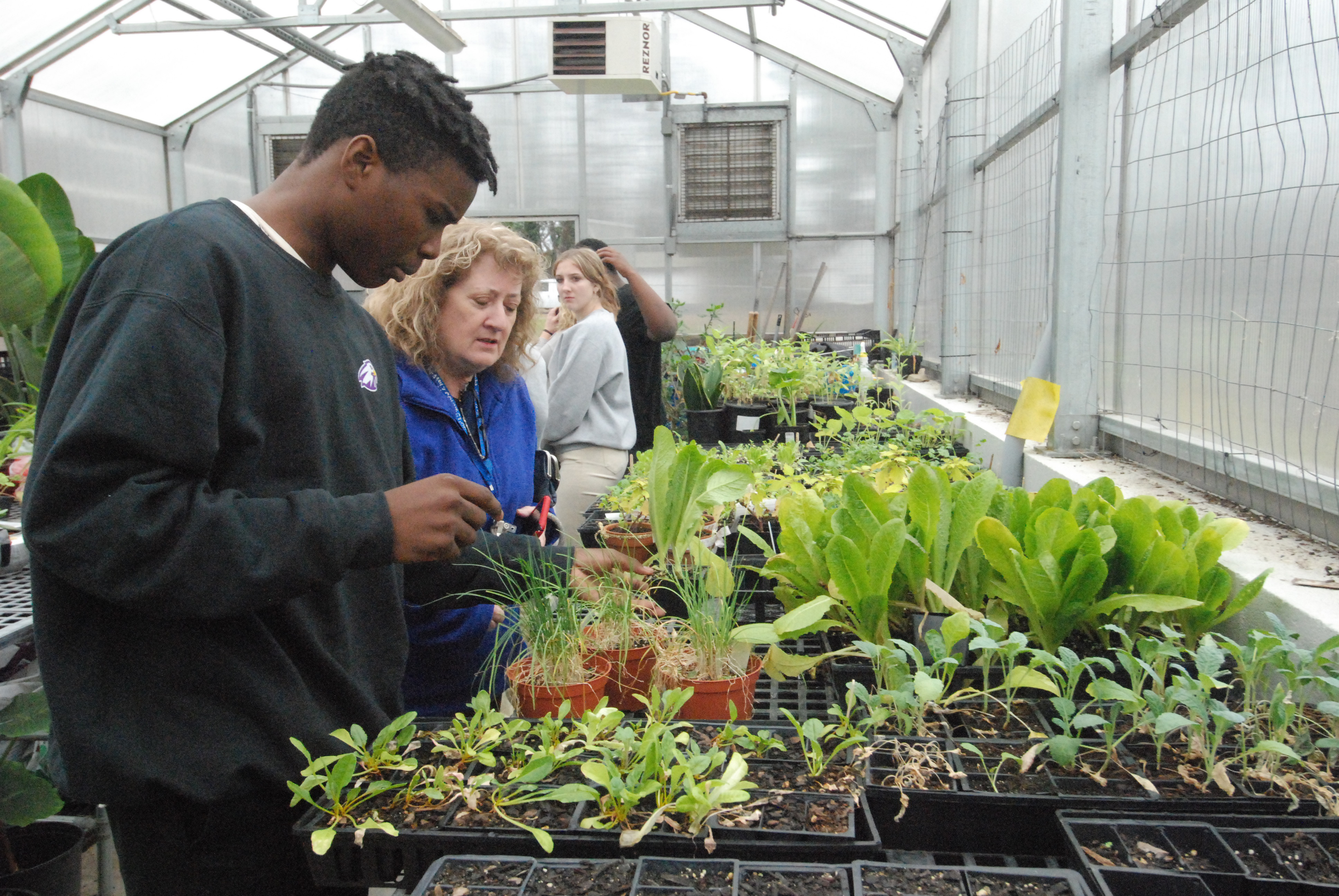Making the most of a make-ahead turkey gravy
Published 12:00 am Tuesday, November 11, 2014

- This Oct. 20, 2014, photo shows homemade gravy in Concord, N.H. The turkey stock used in this gravy recipe takes a few hours to make, but it is mostly hands off. The gravy itself also can be prepped ahead up to the point of needing the roasted turkey drippings, then quickly finished just before serving. (AP Photo/Matthew Mead)
By Sara Moulton
Associated Press
For the home cook, Thanksgiving can be the most stressful day of the year. The crux of the problem is not only the extravagant length of the menu, but the need to serve every dish piping hot at exactly the same moment, a problem made all the more acute by the fact that the oven is probably going to be hogged by the big bird for most of the day.
What’s a cook to do?
I’ll offer two pieces of advice. First, keep in mind that the turkey will stay rip-roaring hot for up to an hour after you pull it from the oven. This gives us ample time to use the oven to cook the stuffing or pies. Secondly, many dishes can be made a day ahead. The obvious candidates are casseroles and stuffing. But there’s another do-ahead you may not have considered — the gravy. Here’s how it’s done.
It’s the day before Thanksgiving. Start by making a stock. Ideally, your turkey will have defrosted enough by then to allow you to extract the package of giblets and the neck from inside the bird’s cavity. (Sometimes it’s placed under the skin flap at the bottom of the bird). You should also cut off the last joint of the turkey wings.
Combine all these parts in a pot with chicken broth and vegetables and simmer for several hours. (But leave out the liver, which would make your stock bitter. Instead, saute it up as a little snack for yourself while you cook.) Starting with chicken broth rather than water seriously amps the flavor, but you’re welcome to use water. Then again, if making turkey stock from scratch strikes you as too much trouble, just omit this step and start your gravy with store-bought chicken broth.
How much gravy do you need? I recommend 1/2 cup per person, which should ensure that there’ll be plenty left over. If you’re having eight folks at the big meal, you’ll need to start with a quart of stock.
To turn the stock into gravy, it must be thickened. The formula is 2 tablespoons each of fat and flour for every cup of liquid. So, a quart of stock (4 cups) will require 1/2 cup (one stick) of butter and 1/2 cup of flour, preferably Wondra. Introduced in 1963, Wondra is “instant” flour formulated to help prevent lumps. (It also does a splendid job as a coating for fish or meat in a sauteed dish.) If you can’t find Wondra, all-purpose flour will do.
Flour tastes raw unless you cook it both before and after you add the liquid. So start by melting the butter in a saucepan, adding the flour, and cooking it for several minutes. Heat the stock to roughly the same temperature as the roux (the flour-butter mixture) before mix them together.
In my experience, this step gets me that much closer to lump-free perfection, though there is no hard rule about the temperature of the liquid. What’s beyond dispute is the importance of mixing well and constantly when you do combine the roux and the liquid. The right tool for the job? A flat whisk. It helps you get into the corners of the saucepan where the roux tends to stick. Don’t have one? A wooden spoon or rubber spatula with a squared corner also works.
To maximize the flour’s thickening ability, it must be heated to no less than 200 F. Then let the gravy simmer for at least as many minutes as you have tablespoons of flour. Season it, then place a sheet of parchment paper or plastic wrap on the gravy’s surface to prevent a skin from forming while it cools, then chill it.
On the great day itself, after you’ve transferred the turkey to a platter to rest, you should “marry” the gravy to the pan drippings by deglazing the bottom of the pan (with all those tasty bits) using wine, broth or water. Then add your make-ahead gravy and heat it up.
Phew! Simple, right? At the very least, this strategy saves you the stress of having to conjure up a boatload of gravy at the critical moment. More importantly, I think the gravy tastes even better when made this way.
Make-Ahead Turkey Gravy
The turkey stock used in this gravy recipe takes a few hours to make, but it is mostly hands off. It can be done up to several days ahead of time and refrigerated. The gravy itself also can be prepped ahead up to the point of needing the roasted turkey drippings, then quickly finished just before serving. Don’t feel like making your own turkey stock. Use chicken stock and start the recipe at the “To prepare the gravy” stage.
When stirring the gravy, a flat whisk is the best tool for the job. But if you don’t have one, a wooden spoon or rubber spatula with a squared corner should work just as well to let you get into the corners of the pan.
Start to finish: 4 hours (30 minutes active)
Servings: 8
For the stock:
The giblets, neck and wing tips from 1 turkey
4 cups low-sodium chicken broth or water
1 small yellow onion, coarsely chopped
1 small carrot, halved lengthwise
1 celery rib, halved lengthwise
1 small parsnip, halved lengthwise
1 sprig fresh thyme
1 sprig fresh parsley
1 bay leaf
1 teaspoon whole black peppercorns
For the gravy:
1/2 cup turkey fat (skimmed from the stock) or butter
1/3 cup Wondra flour or all-purpose flour
Salt and ground black pepper
1 cup dry white wine (optional)
To prepare the stock, in a small to medium saucepan over medium-high heat, combine the giblets, neck and wing tips with the chicken broth. Bring to a boil, then immediately reduce to a simmer, skimming and discarding the scum that rises to the surface.
After about 20 minutes, when there is no more scum rising to the surface, add the onion, carrot, celery, parsnip, thyme, parsley, bay leaf and peppercorns. Return to a simmer and cook, adding water as needed to maintain the level, for 3 to 4 hours. Set aside to cool. Once cooled, skim off and reserve any fat that accumulates on the surface. Strain the stock and discard the solids. Set the stock aside.
To prepare the gravy, if your stock has been chilled, heat it just to a simmer.
In a medium skillet over medium-low, heat the turkey fat until melted. If you don’t have a full 1/2 cup of fat from making the stock, substitute butter for the missing fat. Add the flour and whisk until the roux (the butter-flour mixture) looks like wet sand, about 2 to 3 minutes.
Add the warm stock in a stream, whisking or stirring, and bring it to a boil. Turn down the heat and simmer the gravy, stirring occasionally, for 8 minutes. Don’t worry if the gravy seems thick, you will be adding more liquid when you finish it. Season with salt and pepper. Let cool slightly, transfer to a bowl and cover the surface of the gravy with kitchen parchment. Cover the bowl with plastic wrap and chill until ready to use.
When the turkey is cooked and resting on a platter, it is time to finish the gravy. Pour off any fat from the roasting pan, then place the pan over 2 burners. Heat the pan over medium heat. Add the wine, if using, or a cup of chicken broth or water to the pan and simmer, scraping up the brown bits with a metal spatula, until the liquid is reduced by half.
Add the make-ahead gravy, stirring, and some of the juices from the turkey resting platter. Simmer the gravy in the pan until it is reduced to the desired consistency. Season with salt and pepper.
Nutrition information per serving: 170 calories; 110 calories from fat (65 percent of total calories); 12 g fat (8 g saturated; 0 g trans fats); 35 mg cholesterol; 7 g carbohydrate; 1 g fiber; 1 g sugar; 2 g protein; 130 mg sodium.
Sara Moulton was executive chef at Gourmet magazine for nearly 25 years, and spent a decade hosting several Food Network shows. She currently stars in public television’s “Sara’s Weeknight Meals” and has written three cookbooks, including “Sara Moulton’s Everyday Family Dinners.”






